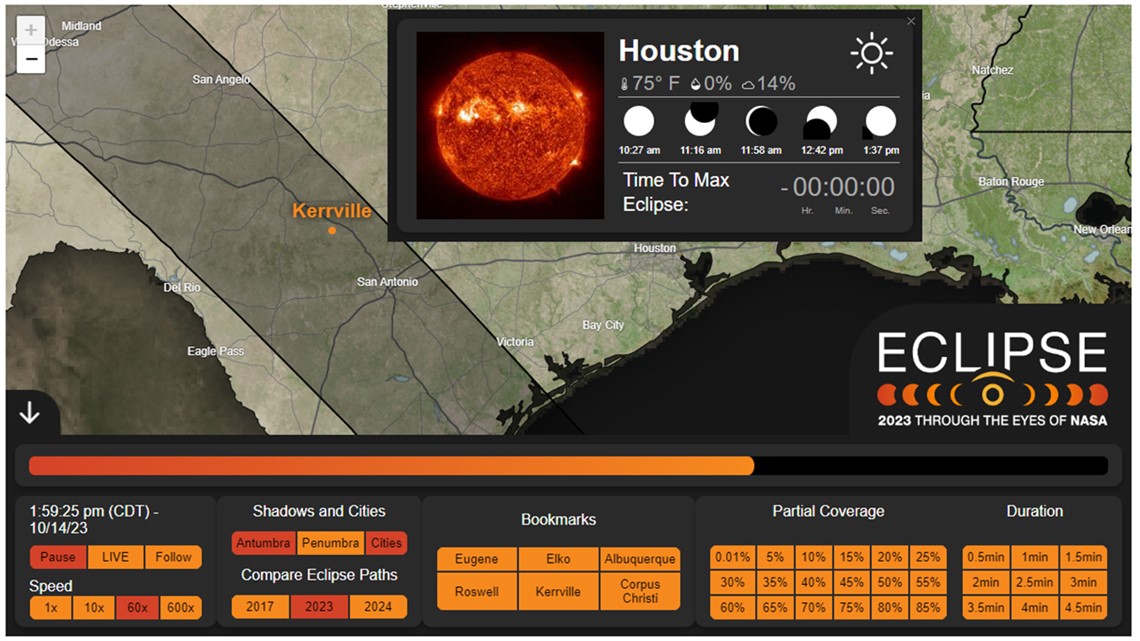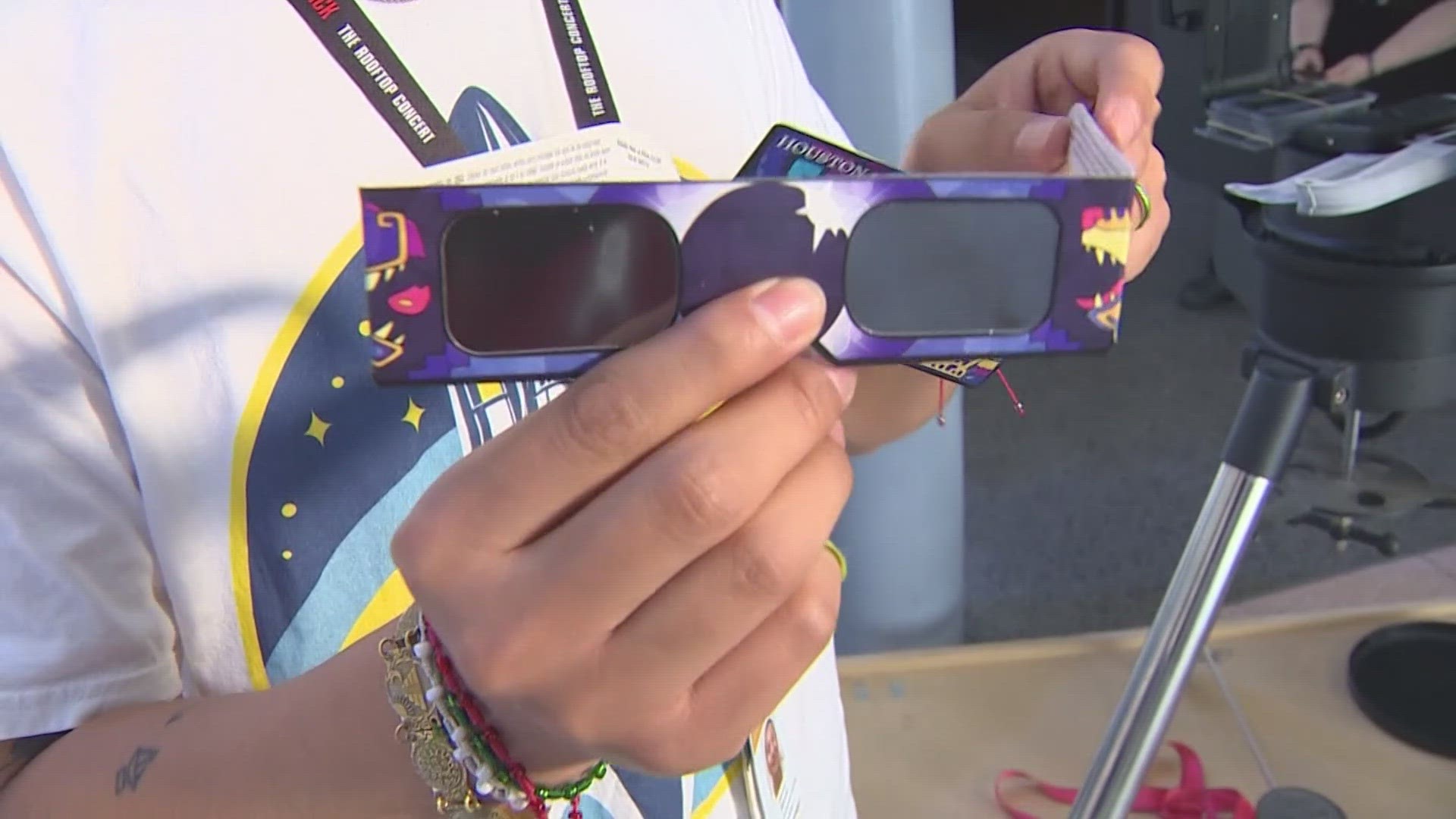HOUSTON — A "Ring of Fire" annular solar eclipse will be visible across the United States and other parts of the world today.
An annular eclipse is when the moon passes between the Earth and sun and is at or near its farthest point of orbit from Earth.
Texas is included in the path. The 100 percent coverage path across Texas includes Midland-Odessa, San Antonio and Corpus Christi.
So what can we expect in Houston, or anywhere else in the U.S.? The Houston area should get between 80 and 85 percent viewing coverage.
NASA has an interactive map -- their Eclipse Explorer -- that can show you what to expect in different parts of the country. Below is an example for Houston.


In Houston, it’ll start around 10:27 a.m. and you’ll notice the moon start to move in front of the sun by 11:16 a.m. Our best view of the eclipse will be at 11:58 a.m. It starts to move away at 12:42 p.m. and then is over by 1:37 a.m.
What is a 'Ring of Fire' annular solar eclipse?
During a "Ring of Fire" annular eclipse, the moon is at its orbit farthest from Earth. Because it’s farther than it is during a total solar eclipse, it doesn’t cover the entire sun, leaving what appears to be a ring of the sun visible for those who are in the path. That's where the "Ring of Fire" eclipse got its name.
Best spots to watch the 'Ring of Fire' annular eclipse
If you're up for a road trip, Space.com lists New Braunfels as one of the Top 7 spots to see it in the southwestern United States. The website specifically mentions a cluster of superstores at I-35 and Highway 46.
Here are other locations across Texas and times in the path of the eclipse
- Midland: 10:18 a.m. through 1:21 p.m., with max eclipse beginning at 11:43 a.m.
- San Angelo: 10:20 a.m. through 1:25 p.m., with max eclipse beginning at 11:47 a.m.
- Kerrville: 10:22 a.m. through 1:30 p.m., with max eclipse beginning at 11:50 a.m.
- San Antonio: 10:23 a.m. through 1:32 p.m., with max eclipse beginning at 11:52 a.m.
- Corpus Christi: 10:26 a.m. through 1:38 p.m., with max eclipse beginning at 11:55 a.m.
If you don't want to go outside to see it, NASA is streaming the annular eclipse. Here's where you can access their live stream, which begins at 10:30 a.m. Central Time on October 14 and goes through 12:15 p.m. Central Time.
In the Houston area, there are plenty of options to see it, including the following:
The Children's Museum eclipse viewing party in Houston
The viewing party begins at 10 a.m. and goes through 2 p.m. You can grab a pair of special glasses to catch the eclipse or you can watch a live stream indoors. Plus, kids -- and adults -- can get an educational experience about eclipses. More information here.
Houston Museum of Natural Science
The annular eclipse viewing party will be in full swing at Houston Museum of Natural Sciences, and the viewing party goes from 10 a.m. to 2 p.m. More information here.
George Observatory in Needville
You can see the "Ring of Fire" from the George Observatory in Needville. The viewing starts at 10 a.m. and lasts until 2 p.m. Parking is $10 and entry is $7. Anyone under 12 years old is free. More information here.
Delores Fenwick Nature Center in Pearland
The viewing will go from 10 a.m. until 12:30 p.m. There will be a variety of free activities, crafts and games. Eclipse viewing glasses will be available while they last. More information here.
How to protect your eyes during an eclipse
It's not safe to look directly at an eclipse. If you do, you could cause instant damage to your eyes. That goes for cameras, telescopes or binoculars without special-purpose solar filters, too. Regular sunglasses are not protection either. You need to use special social viewing glasses or a safe handheld viewer. And make sure the lens is not damaged or scratched.
The American Astronomical Society Solar Eclipse Task Force keeps a list of manufacturers, distributors and sellers of eclipse glasses and filters that they consider legitimately compliant with the standard. Click here for that list.
If you didn't order them in time, the AAS recommends checking with Home Depot, Lowe's or Walmart to check if they have any in stock. (Some, but not all, locations sell ISO-approved eclipse glasses, according to the AAS.) Additionally, many libraries around the U.S. will be giving away free pairs of approved eclipse glasses; call your local branch or check this site for a map of participating libraries.
If you don't have special eclipse glasses, you can use an indirect viewing method, like a pinhole projector which has a small opening that can project an image of the sun onto a surface. Here's guidance from NASA on safe solar eclipse viewing.
When is the next eclipse?
A total solar eclipse will happen on April 8, 2024, and will also travel over several states, including Texas. In fact, the path of April's eclipse crosses the path of this year's October eclipse in Texas.

